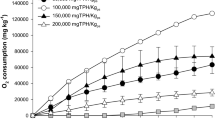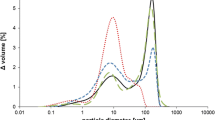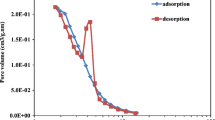Abstract
Desorption of eight polycyclic aromatic hydrocarbons (PAH) fromtwo harbour sludges from the Port of Rotterdam, the Netherlands,was studied by column elution experiments. When water moves in a sludge layer desorbing contaminants like PAH can be dispersedin the environment. Separation of liquid and solid phase inbatches of sludge, stored for more than three years, by ultra-centrifugation at 4 °C yielded equilibrium partition coefficients. Temperature effects could not account for the observed differences with reported literature values. The differences are attributed to the contact time of PAH in thesediment. Laboratory data reported in the literature were oftenobtained after short contact times and therefore may not represent equilibrium partitioning. Our values represent contacttimes in excess of three years and are therefore more representative for the field conditions. Partition coefficientsobtained from column elution experiments were slightly above those obtained from the batch experiments. During column elutionof the sludge from the Beneden Merwede sorption equilibriumwas absent for the lighter compounds. This is attributed to the presence of a large portion of immobile water in the columns. Elution in the Beerkanaal columns occurred at near sorption equilibrium although pore water velocities were higher. Assumingthat desorption is diffusion controlled, observed desorption inboth materials could be explained. The non-equilibrium desorptionin the Beneden Merwede sludge for phenanthrene, and to alesser extent for anthracene and fluoranthene, could be describedby a diffusion limited model assuming spherical particles.
Similar content being viewed by others
References
Abdul, A. S., Gibson, T. L. and Rai, D. N.: 1990, ‘Use of humic acid solution to remove organic contaminants from hydrogeological systems’, Environ. Sci. Technol. 24, 328–333.
Ball, W. P. and Roberts, P. V.: 1991, ‘Long-term sorption of halogenated organic chemicals by aquifer material. 2. Interparticle diffussion’, Environ. Sci. Technol. 25, 1237–1249.
Beigel, C. and Di Pietro, L.: 1999, ‘Transport of triticonazole in homogeneous soil columns: Influence of nonequilibrium sorption’, Soil Sci. Soc. Am. J. 63, 1077–1086.
Brusseau, M. L., Jessup, R. E. and Rao, P. S. C.: 1991a, ‘Nonequilibrium sorption of organic chemicals: Elucidation of rate-limiting processes’, Environ. Sci. Technol. 25, 134–142.
Brusseau, M. L., Larsen, T. and Christensen, T. H.: 1991b, ‘Rate-limited sorption and nonequilibrium transport of organic chemicals in low organic carbon aquifer materials’, Water Res. Res. 27, 1137–1145.
Chiou, C. T., Porter, L. J. and Schmedding, D. W.: 1983, ‘Partition equilibria of nonionic organic compounds between soil organic matter and water’, Environ. Sci. Technol. 17, 227–231.
Coates, J. D., Anderson, R. T. and Lovley, D. R.: 1996a, ‘Oxidation of polycyclic aromatic hydrocarbons under sulphate-reducing conditions’, Appl. Environ. Microbio. 62, 1099–1101.
Coates, J. D., Anderson, R. T., Woodward, J. C., Phillips, E. J. P. and Lovley, D. R.: 1996b, ‘Anaerobic hydrocarbon degradation in petroleum-contaminated harbor sediments under sulfate-reducing and artificially imposed iron-reducing conditions’, Environ. Sci. Technol. 30, 2784–2789.
Coates, J. D., Woodward, J. C., Allen, J., Philp, P. and Lovley, D. R.: 1997, ‘Anaerobic degradation of polycyclic aromatic hydrocarbons and alkenes in petroleum-contaminated marine harbor sediments’, Appl. Environ. Microbiol. 63, 3589–3593.
Cornelissen, G.: 1999, ‘Mechanisms and consequences of slow desorption of organic compounds from sediments’, Ph.D. Thesis, Universiteit van Amsterdam, Amsterdam, The Netherlands.
Crank, J.: 1975, The Mathematics of Diffusion, Clarendon Press, Oxford, U.K.
Crunkilton, R. L. and DeVita, W. M.: 1997, ‘Determination of aqueous concentrations of polycyclic aromatic hydrocarbons (PAHs) in an urban stream’, Chemosphere 35, 1447–1463.
De Maagd, P. G.-J.: 1996, ‘Polycyclic aromatic hydrocarbons: Fate and effects in the aquatic environment’, Ph.D. Thesis, Utrecht University, Utrecht, The Netherlands.
De Maagd, P. G.-J., Ten Hulscher, D. T. E. M., Van den Heuvel, H., Opperhuizen, A. and Sijm, D. T. H. M.: 1998, ‘Physicochemical properties of polycyclic aromatic hydrocarbons: Aqueous solubilities, n-octanol/water partition coefficients, and Henry's law constants’, Environ. Toxicol. Chem. 17, 251–257.
Dewulf, J., Van Langenhove, H. and Grare, S.: 1999, ‘Sediment/water and octanol/water equilibrium partitioning of volatile organic compounds: temperature dependence in the 2–25 °C range’, Water Res. 33, 2424–2436.
Domenico, P. A. and Schwartz, F. W.: 1990, Physical and Chemical Hydrogeology, John Wiley, New York, NY, U.S.A.
Dunnivant, F. M., Jardine, P. M., Taylor, D. L. and McCarthy, J. F.: 1992, ‘Transport of naturally occuring dissolved organic carbon in laboratory columns containing aquifer material’, Soil Sci. Soc. Am. J. 56, 437–444.
Enfield, C. G., Bengtsson, G. and Lindqvist, R.: 1989, ‘Influence of macromolecules on chemical transport’, Environ. Sci. Technol. 23, 1278–1286.
Gaber, H. M., Inskeep, W. P., Comfort, S. D. and Wraith, J. M.: 1995, ‘Nonequilibrium transport of atrazine through large intact soil cores’, Soil Sci. Soc. Am. J. 59, 60–67.
Grathwohl, P. and Reinhard, M.: 1993, ‘Desorption of trichloroethylene in aquifer material: Rate limitation at the grain scale’, Environ. Sci. Technol. 27, 2360–2366.
Grathwohl, P., Gewald, T., Pyka, W. and Schüth, C.: 1993, ‘Determination of Pollutant Release Rates from Contaminated Aquifer Materials’, in F. Arendt, G. J. Annokkée, R. Bosman and W. J. Van der Brink (eds), Contaminated Soil' 93, Kluwer, Dordrecht, The Netherlands, pp. 175–184.
Grathwohl, P., Pyka, W. and Merkel, P.: 1994, ‘Desorption of Organic Pollutants (PAHs) from Contaminated Aquifer Material’, in T. Dracos and F. Stauffer (eds), AIRH Symposium on Transport and Reactive Processes in Aquifers, Balkema, Amsterdam, The Netherlands, pp. 469–474.
He, Y., Yediler, A., Sun, T. and Kettrup, A.: 1995, ‘Adsorption of fluoranthrene on soil and lava: Effects of the organic carbon contents of adsorbents and temperature’, Chemosphere 30, 141–150.
Hegeman, W. J. M., Van der Weijden, C. H. and Loch, J. P. G.: 1995, ‘Sorption of benzo(a)pyrene and phenanthrene on suspended harbour sediment as a function of suspended sediment concentration and salinity: A laboratory study using the cosolvent partition coefficient’, Environ. Sci. Technol. 29, 363–371.
Karickhoff, S. W., Brown, D. S. and Scott, T. A.: 1979, ‘Sorption of hydrophobic pollutants on natural sediments’, Water Res. 13, 241–248.
Keijzer, Th. J. S.: 2000, ‘Chemical osmosis in natural clayey materials’, Geologica Ultraiectina 196, Ph.D. Thesis, Universiteit Utrecht, Utrecht, The Netherlands.
Keijzer, Th. J. S, and Loch, J. P. G.: 2001, ‘Chemical osmosis in compacted dredging sludge’, Soil Sci. Soc. Am. J. 65, 1045–1055.
Kicinski, H.-G.: 1992, ‘PAH-Festphasenextraction aus Wasserproben (Trinkwasser und maessig belastetes Oberflachenwasser) durch Hyaminzusatz’, Z. Wasser-Abwass-Forsch. 25, 289–294.
Kookana, R. S., Schuller, R. D. and Aylmore, L. A. G.: 1993, ‘Simulation of simazine transport through soil columns using time-dependent sorption data measured under flow conditions’, J Cont. Hydrol. 14, 93–115.
Langenhoff, A. A. M., Zehnder, A. J. B. and Schraa, G.: 1996, ‘Behaviour of toluene, benzene and naphthalene under anaerobic conditions in sediment columns’, Biodegradation 7, 267–274.
Liu, H. and Amy, G.: 1993, ‘Modeling partitioning and transport interactions between natural organic matter and polynuclear aromatic hydrocarbons in groundwater’, Environ. Sci. Technol. 27, 1553–1562.
Loch, J. P. G.: 1996, ‘Behaviour and Fate of Organic Contaminants in Soil and Groundwater’, in H. F. A. M. de Haan and M. I. Visser-Reyneveld (eds), Soil Pollution and Soil Protection, International Training Centre (PHLO), Agricultural University Wageningen, Wageningen, The Netherlands, pp. 181–199.
Lüers, F. and Ten Hulscher, Th. E. M.: 1996, ‘Temperature effect on the partitioning of polycyclic aromatic hydrocarbons between natural organic carbon and water’, Chemosphere 33, 643–657.
Mackay, D., Shiu, W. Y. and Ma, K. C.: 1992, Illustrated Handbook of Physical-Chemical Properties and Environmental Fate for Organic Chemicals, Lewis, London, U.K.
Maxin, C. R. and Kögel-Knabner, I.: 1995, ‘Partitioning of polycyclic aromatic hydrocarbons (PAH) to water-soluble soil organic matter’, Eur. J. Soil Sci. 46, 193–204.
Meckenstock, R. U., Annweiler, E., Michaelis, W., Richnow, H. H. and Schink, B.: 2000, ‘Anaerobic napthalene degradation by a sulfate-reducing enrichment culture’, Appl. Environ. Microbiol. 66, 2743–2747.
Piatt, J. J., Backus, D. A., Capel, P. D. and Eisenreich, S. J.: 1996, ‘Temperature-dependent sorption of napthalene, phenanthrene and pyrene to low organic carbon aquifer sediments’, Environ. Sci. Technol. 30, 751–760.
Puchelt, H. and Bergfeldt, B.: 1992, ‘Major and Trace Element Concentrations in Waters Centrifuged from Unsaturated Soils’, in Y. K. Kharaha and A. S. Meast (eds), Proceedings of the 7th International Symposium on Water-rock Interaction, Vol. 1. Low Temperature Environments, Park City, Utah, U.S.A., pp. 751–752.
Schrap, S. M. and Opperhuizen, A.: 1992, ‘On the contradictions between experimental sorption data and the sorption partitioning model’, Chemosphere 24, 1259–1282.
Schüth, C. and Grathwohl, P.: 1994, ‘Nonequilibrium Transport of PAHs: A Comparison of Column and Batch Experiments’, in T. Dracos and F. Stauffer (eds), AIRH Symposium on Transport and Reactive Processes in Aquifers, Balkema, Amsterdam, The Netherlands, 143–148.
Schwarzenbach, R. P., Gschwend, P. M. and Imboden, D. M.: 1993, Environmental Organic Chemistry, Wiley, New York, NY, U.S.A.
Stigliani, W. M., Jaffe, P. R. and Anderberg, S.: 1993, ‘Heavy metal pollution in the Rhine basin’, Environ. Sci. Technol. 27, 786–793.
Ten Hulscher, Th. E. M. and Cornelissen, G.: 1995, ‘Effect of temperature on sorption equilibrium and sorption kinetics of organic micropollutanys – A review’, Chemosphere 32, 609–626.
Thierrin, J., Davis, G.B., Barber, C., Patterson, B.M., Pribac, F., Power, T.R.and Lambert, M.: 1993, ‘Natural degradation rates of BTEX compounds and naphthalene in a sulphate reducing groundwater environment’, Hydrol. Sci. J. 38, 309–322.
Totsche, K. U., Danzer, J. and Kögel-Knabner, I.: 1997, ‘Dissolved organic matter enhanced retention of polycyclic aromatic hydrocarbons in soil miscible displacement experiments’, J. Environ. Qual. 26, 1090–1100.
Van Agteren, M. H., Keuning, S. and Janssen, D. B.: 1998, Handbook of Biodegradation and Biological Treatment of Hazardous Organic Compounds. Environment and Chemistry,Vol. 2, Kluwer, Dordrecht, The Netherlands.
Van Beek, C. G. E. M. and Pal, R. A. J.: 1978. ‘The influence of cation exchange and gypsum solubility on the transport of sodium, calcium and sulphate through soils’, J. Hydrol. 36, 133–142.
Van Zoest, R. and Van Eck, G. T. M.: 1993. ‘Historical input and behaviour of hexachlorobenzene, polychlorinated biphenyls and polycyclic aromatic hydrocarbons in two dated sediment cores from the Scheldt estuary, SW Netherlands’, Marine Chem. 44, 95–103.
Wilkens, B. J.: 1995, ‘Evidence of groundwater contamination by heavy metals through soil passage under acidifying conditions, Geologica Ultraiectina 129’, Ph.D. Thesis, Universiteit Utrecht, Utrecht, The Netherlands.
Wu, S.-C. and Gschwend, M.: 1986. ‘Sorption kinetics of hydrophobic organic compounds to natural sediments and soils’, Environ. Sci. Technol. 20, 717–725.
Zhang, X. and Young, L. Y.: 1997. ‘Carboxylation as an initial reaction in the anaerobic metabolism of naphthalene and phenanthrene by sulfidogenic consortia’, Appl. Environ. Microbiol. 63, 4759–4764.
Author information
Authors and Affiliations
Corresponding author
Rights and permissions
About this article
Cite this article
Keijzer, T.J.S., Middeldorp, P.F., van Alphen, M. et al. Desorption Behaviour of Polycyclic Aromatic Hydrocarbons in Harbour Sludge from the Port of Rotterdam, The Netherlands. Water, Air, & Soil Pollution 136, 361–385 (2002). https://doi.org/10.1023/A:1015247311769
Issue Date:
DOI: https://doi.org/10.1023/A:1015247311769




